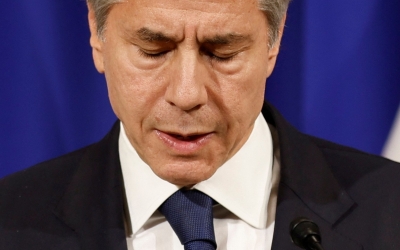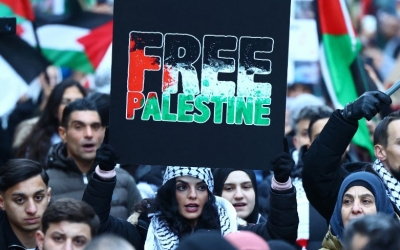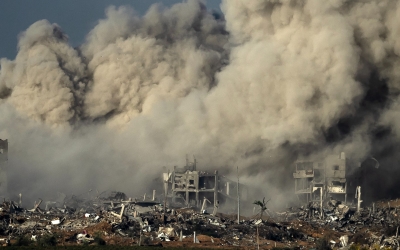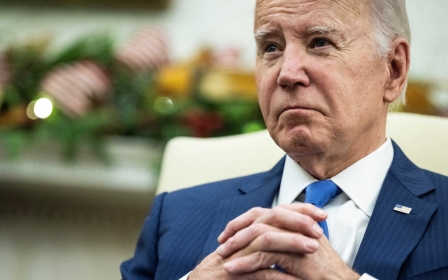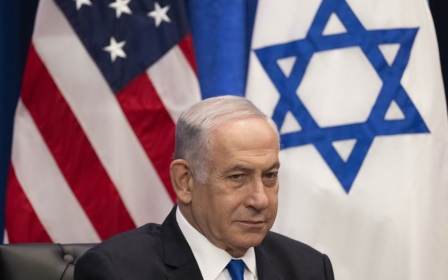Israel-Palestine war: Why Biden's 'day after' means two-state apartheid
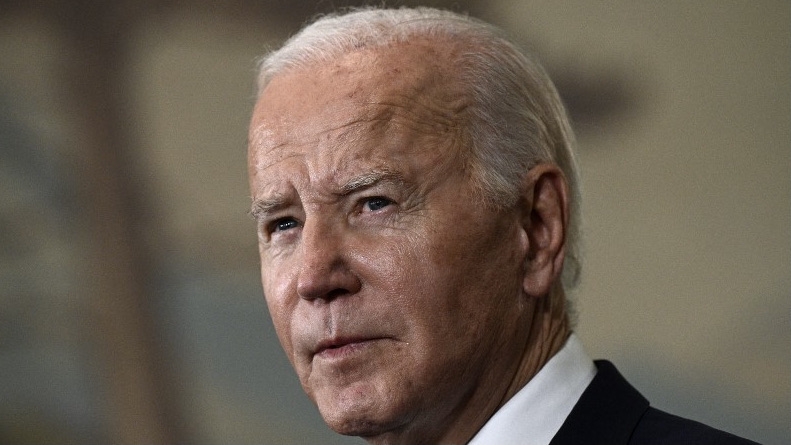
As our attention is focused on the wholesale destruction being unleashed on Gaza by Israel, as it strives to destroy Hamas, while the fate of hostages is in the balance, a far more decisive set of events is being played out in the occupied West Bank.
Haaretz and other media have been reporting on attacks by settlers and soldiers on Palestinians living in the West Bank. I myself have experienced such attacks.
Unlike Gaza, it is the bureaucratically termed Area C, the 62 percent of the West Bank where the settlements are located, that represents the heart of Greater Israel. And not only for the Israeli secular and religious right - for the Zionist left as well. The massive settlement blocs of Area C “fall into the national consensus”, while the Israeli military insists that retaining it is crucial for national security.
And so, without fanfare or meaningful protest, mopping up operations have begun. The violent "hilltop youth" have been let loose on the few Palestinian villages remaining in Area C to cleanse it of a Palestinian presence.
These unrestrained settler gangs operate both under the protection of Israeli soldiers, or act as soldiers through the special Desert Frontier unit, established ostensibly to “protect the settlements”. At least 16 Palestinian enclaves and villages have been abandoned.
New MEE newsletter: Jerusalem Dispatch
Sign up to get the latest insights and analysis on Israel-Palestine, alongside Turkey Unpacked and other MEE newsletters
Mopping up operations, however, do not stand on their own. They represent the final stages of a larger, long-planned political agenda.
The final push to ethnically cleanse Area C must be understood as part of the "day after", the new political reality that will follow the Gazan fighting.
Indeed, on 25 October, even as the world was reeling from the trauma of 7 October and Israel’s devastating retaliation, US President Joe Biden casually announced that “when this crisis is over, there has to be a vision of what comes next, and, in our view, it has to be a two-state solution”.
The US, supported by its European allies, Biden informed us, would convene “Israelis, Palestinians, regional partners, global leaders” for “a concentrated effort to put us on a path toward peace”.
Regional and global concerns
But Biden is not talking about a “peace process” or negotiations drawn out over years. No, there are far more pressing regional and global concerns to worry about without the pesky Palestinian issue.
These include securing oil and energy, and countering Iranian, Russian and Chinese challenges in the region. These require a Middle Eastern "Nato", led by Israel and Saudi Arabia, to pursue western hegemony in the region and globally.
Follow Middle East Eye's live coverage for the latest on the Israel-Palestine war
Just a month before 7 October, Biden signed an agreement for the construction of the India-Middle East-Europe Economic Corridor (IMEC), to run from India to Europe through the United Arab Emirates, Saudi Arabia, Jordan, Israel and Greece to counteract the Chinese Belt and Road Initiative.
This addresses the aspirations of Saudi Arabia and the Gulf states to become global economic hubs. It should also bring “industrial quiet” to the region by satisfying Israel’s aspirations for a Greater Israel, which requires imposing on the Palestinians a truncated Bantustan state in Areas A and B and a perhaps depopulated Gaza.
All of this would require a return to “normalisation”, with a militarily hegemonic Israel integrated “peacefully” into the region.
In principle, a genuine two-state solution might have worked. It was not a just solution, of course. The Palestinians would have received only 22 percent of their homeland, even if they could have recovered all the occupied territory.
But it did offer them a potentially viable state with borders to Jordan, Egypt and Israel, as well as access to the sea.
When the PLO accepted the two-state solution in 1988, a Palestinian mini-state may still have been feasible. Back then there were fewer than 100,000 settlers in the West Bank.
The Arab core of East Jerusalem, the Old City and its urban environs were still intact. And only about 4,000 Israelis lived in isolated pockets of Gaza.
Logistically (if not, in hindsight, politically), the idea of detaching a coherent Palestinian territory from Israeli control without touching a single inch of sovereign Israeli territory appeared an eminently workable solution. Had it wished, Israel could have had peace, security and 78 percent of the land 35 years ago.
Viable Palestinian state
As it is, the two-state solution has turned into a recipe for apartheid. Why? Well, let’s briefly contrast the conditions necessary for a truly sovereign and viable Palestinian state with Israeli policy and the “facts on the ground”.
Firstly, any Palestinian state must have control over its internationally recognised borders.
Secondly, it must also be territorially contiguous. In order to make the West Bank a coherent state territory, most or all of Israel’s settlements would have to be removed, since their very location was strategically planned to guarantee permanent Israeli control. And an extraterritorial passage for people and goods would have to be established between the West Bank and Gaza.
Thirdly, within its national territory, a Palestinian state has to exercise sovereign control over all its resources, from natural resources such as water, land and minerals, to sacred sites and tourist attractions.
Any Palestinian state must be governed by a government elected by its citizens. No more Palestinian 'Authority', with limited jurisdiction over tiny pieces of territory
In that vein, fourthly it must include East Jerusalem, the most significant symbol of Palestinian national and religious life and a major part of its economy - tourism being Palestine’s largest industry. (An arrangement for shared sovereignty over the Old City may be possible.)
Fifthly, as opposed to Israel’s demand that the Palestinian state be demilitarised, it must have the ability to defend its sovereignty and territory. At the least a Palestinian armed force is required that has policing capabilities within the state’s borders and sovereignty of action on them, backed up by international guarantees of the state’s sovereignty.
Sixthly, no settlement would be possible without the right of the refugees and their descendants to return. A key consideration regarding the viability of a Palestinian mini-state is whether it is able to repatriate the refugees who choose to return, as well as provide for future generations.
And finally, the Palestinian state must be governed by a genuine government elected by its citizens. No more Palestinian “Authority”, with limited jurisdiction over tiny pieces of territory, whose very existence is dependent upon Israeli goodwill, and whose job is ensuring the security of Israelis rather than its own population.
Unilateral national project
This is where, as they say, the rubber meets the road. Each of these conditions requires political and military concessions that contradict and even defeat the very purpose of Zionism.
There is no Israeli-Palestine conflict. From the start, Zionism has been a unilateral national project dedicated to Judaising Palestine. “Redeeming” the Land of Israel, in Zionist language, by definition requires displacing the country’s Arab population, seizing its land and, through settlement, replacing an Arab Palestine with a Jewish Israel.
The political “fact” of the state received international recognition in 1949. The effort to gain international recognition for a Greater Israel extending over all of historic Palestine began immediately after the 1967 war.
It took on a more deliberate form in 1977, when Ariel Sharon was appointed chairman of the Ministerial Committee for Settlement Affairs in the new Menachem Begin government.
His strategy of imposing massive “facts on the ground” created a fait accompli. More than 750,000 settlers now live throughout the Occupied Palestine Territory (OPT), many in large settlement cities.
Individual settlements have been consolidated into a grid of seven settlement blocs whose function is to perpetuate Israeli control of the West Bank and confine the Palestinian population to small, fragmented enclaves.
A network of highways incorporates the West Bank into Israeli proper. East Jerusalem was annexed in 1967 and disconnected from the West Bank as an economic, religious and cultural centre. And in 2019, Prime Minister Benjamin Netanyahu announced plans to annex the Jordan Valley, almost a quarter of the West Bank.
Israel’s 7.2 million Jews control and live on 85 percent of the country’s land, while 7.5 million Palestinians are confined to just 15 percent of the land, 75 percent of them stateless persons.
To the degree that these facts on the ground define the two-state solution of Donald Trump and Biden and do not interfere with Israel’s normalisation with the Arab world, Zionism’s 130-year project of colonising Palestine is nearing competition.
'Defensible borders'
In a country obsessed by security - as all settler-colonial countries must be, since the dispossessed will never cease their resistance - Israel has adopted military doctrines that also prevent the emergence of any sovereign Palestinian state.
These include the doctrine that the Palestinians are Israel’s permanent enemies and constitute a permanent security threat and that there can be no return to the “indefensible” armistice lines of 1949 or the 1967 Green Line, ie permanent military control over the OPT.
That there will be permanent control over “defensible borders” with Arab states, meaning Israeli control over the borders of the Palestinian state. Israel must also control Palestinian airspace and the electro-magnetic (communications) sphere; further,a Palestinian state must be demilitarised and Israel must retain security control. Israel must also maintain an active and constant military presence in the OPT.
That Israel will retain its major settlements and the settlement blocs.
Palestinians must not only recognise the State of Israel but recognise it as a 'Jewish state' - in other words, surrender all claim to Palestine as a national homeland
And even if a Palestinian state were to emerge, it would not have territorial contiguity, only “transportational contiguity” under Israel supervision. The West Bank would be divided into three or four Palestinian cantons, all surrounded by settlement blocs, Israeli highways and military facilities.
A Greater Jerusalem would keep East Jerusalem and the Old City far from Palestinian territory. And any “safe passage” between the West Bank and Gaza would not have extraterritorial status; Israel would retain the right to arrest any Palestinian traversing “Israeli” space.
Further, Israel must control Palestinian foreign policy, including its ability to enter into treaties, and the Palestinians must not only recognise the State of Israel but recognise it as a “Jewish state” - in other words, surrender all claim to Palestine as a national homeland and accept that it belongs, and legitimately belongs, exclusively to the Jews.
Finally, in terms of sovereignty, the best Israel might entertain is “autonomy” over a limited territory.
Two-state apartheid
There is no international will to force Israel to retreat from the OPT.
In an ideal world, where international relations operated in accordance with international law and UN resolutions, Israel’s occupation would have collapsed under the weight of its own illegality and Palestinian national rights would occupy the centre of negotiations.
As it is, there has been no international appetite to oppose or even slow Israel’s relentless Judaisation of Palestine or its imposing of a permanent regime of apartheid.
With all this in mind, it is little wonder that advocates for a just resolution of the Israel/Palestine “conflict” fear what Biden is threatening to impose the "day after".
A truly sovereign and viable Palestinian state alongside Israel is simply not on the cards, with apartheid in the guise of a two-state solution a much more likely prospect.
Given Biden’s unreserved support for Israel’s assault on Gaza, and with the backdrop of his support for Israel stretching back over many decades, what could he have meant when he declared that “there’s no going back to the status quo as it stood on 6 October”?
Whatever a genuinely just solution might be, we must be prepared that the "day after" augurs a two-state apartheid.
The views expressed in this article belong to the author and do not necessarily reflect the editorial policy of Middle East Eye.
Middle East Eye delivers independent and unrivalled coverage and analysis of the Middle East, North Africa and beyond. To learn more about republishing this content and the associated fees, please fill out this form. More about MEE can be found here.



